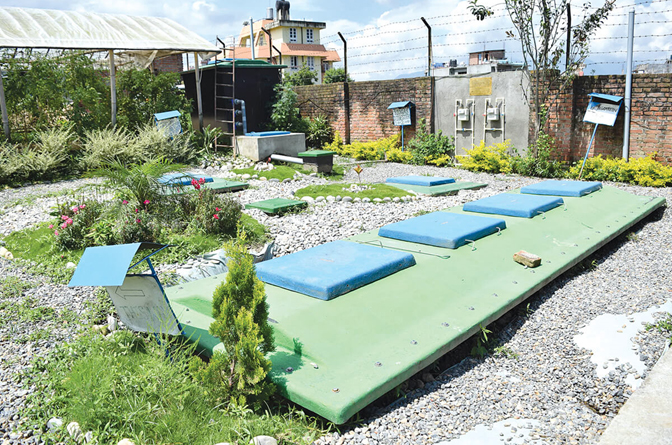
Nepal solved one problem, and created another. After a successful campaign against open defecation, 97% of households in Nepal now have latrines. But what to do with the waste that has accumulated in the pits and sewage?
To solve the growing problem, the Ministry of Water Supply and Sanitation passed the Faecal Sludge Management (FSM) framework for the collection, transport, treatment and disposal of waste in urban areas. For Kathmandu Valley, this will go hand-in-hand with the government’s plan to free the Bagmati of sewage by 2020.
A first-of-its-kind project at an orphanage in Lubhu (pictured above) outside Lalitpur gives a glimpse of how it would work. Septic tank waste is collected from households that pay for the service, transported to the treatment plant to be turned into fertiliser, methane gas and water.
The plant (right) was originally set up to treat waste at shelters after the 2015 earthquake by the German organisation BORDA, Environment and Public Health Organisation (ENPHO), and Saligram Bal Griha. A similar faecal sludge treatment plant has been built in Bardia.
The system treats six cubic metres of sewage per week, with separate solid and liquid units. It takes three days for the sludge to be treated and the water reused for irrigation. The rest flows into a digester to generate biogas, and the effluent takes 12 days to dry into odourless fertiliser.
Vegetables thrive in the nutrient-rich waste, and are enough to feed all 42 children and staff in the orphanage. Extra greens are sold in the market.
“We didn’t have sufficient water to farm in the past, now we can grow our own food, and cook in gas from treated human waste,” says caretaker Surya Prasad Ghimire. With a price tag of Rs7 million, the only downside for now is the cost, but that is because it is a prototype.
When biogas first spread in Nepal 40 years ago, users were squeamish about allowing latrine waste to flow into the digester along with cowdung. By now there are 400,000 household biogas plants in Nepal, and nearly a third of them process both animal and human waste. In addition, 100 Police stations, Army bases and jails use human waste to generate gas for their kitchens.
Explains Prakash Aryal of the Alternative Energy Promotion Centre (AEPC): “There used to be a taboo about linking toilets with biogas, but it is now easier to convince people due to the rise in awareness.”
Source: Nepali Times




